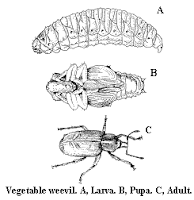
Question: My yellow summer squash is doing weird things this spring. Some are shriveling up on the ends, some have a fuzzy black growth on the ends, and others are just not growing but seem to get darker and tougher skins.
Answer: Congratulations, you have hit the squash problem jackpot or the squash disorder "perfect storm". In this case there are multiple reasons for the multiple problems. Let me take them in order:
First, poor pollination will cause poorly formed fruit and/or fruit end shriveling. Also, the dreaded calcium defeciency can cause similar symptoms as well. Cool soils can contributue to the lack of root growth and the lack of the plants ability to pick up the calcium.
Second, Choanephora fruit rot is favored by wet weather. Both blossoms and fruit are affected and fruit nearest the ground are more likely to become diseased. It is not unusual to find 30-40% of blossoms and/or fruit infected with the fungus. The growth looks like the picture above (from the The American Phytopathological Society website). On the plus side this disease is seldom long lived and will pass when weather conditions change.
Third, the very cool weather this spring (especially at night) has greatly slowed fruit enlargement and has led to slow growing fruit which matures (hence the darker color and tougher skin) without very much fruit enlargement. Pollination also affects fruit size and could be a contributing factor.
Warmer and drier weather will solve all the problems discussed and no treatments are needed.




